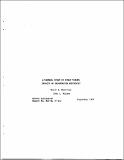| dc.contributor.author | Hamilton, David Andrew | |
| dc.contributor.author | Wilson, John Loyd | |
| dc.date.accessioned | 2006-03-06T16:54:36Z | |
| dc.date.available | 2006-03-06T16:54:36Z | |
| dc.date.issued | 1977 | |
| dc.identifier.other | 03660806 | |
| dc.identifier.uri | http://hdl.handle.net/1721.1/31262 | |
| dc.description | Originally presented as the first author's thesis, (M.S.) in the M.I.T. Dept. of Civil Engineering, 1977. | en |
| dc.description.abstract | This report evaluates the influence of strip mining features, commonly found in the Northern Great Plains Coal Region, on ground
water hydrology. The features examined are: reclaimed mine geometry, relative transmissivity between the reclaimed spoil and the surrounding unmined coal bed aquifer, anisotropy, the gravity sorted rubble layer, coal wedges left between trench cuts, and the position and size
of an operational mine in the regional flow system. A finite element computer model was used to simulate the groundwater flow field from three frames of reference: a local plan view of the mine site (local hydrology), a cross sectional view of flow through the reclaimed mine interior (interior flow), and a cross sectional view of a regional flow system (regional hydrology). The simulation model solved for the piezometric head distribution in each system. For each simulation the piezometric head contours were plotted, and in some cases, the increase in flux induced by the mine
properties, and the contact time of water passing through the reclaimed spoil were calculated. Although only the flow of water
through the spoil was modeled, water quality effects were inferred through a set of indices dealing with the reclaimed mine size and amount of water passing through it. The effects of a reclaimed mine were studied in the local and interior flow simulations. The
influence of an operational mine was examined in the regional simulation. In all cases, the long term impacts were simulated by solving for the steady state condition.
Regional location is found to be the most important factor in the influence of an operational mine on groundwater resources. Relative transmissivity is the most important factor in determining the influence of a reclaimed mine. When present, the rubble layer dominates the flow pattern through the mine spoil. The coal wedges
are apparently of little hydrologic consequence. Equidimensional mine shapes are preferred to elongated shapes because they induce the least amount of flow through the spoil per unit extracted coal. | en |
| dc.description.sponsorship | Prepared with the support of the M.I.T. Energy Laboratory's institutional funds from the U.S. Energy Research and Development Administration and the National Science Foundation. | en |
| dc.format.extent | 6421316 bytes | |
| dc.format.mimetype | application/pdf | |
| dc.language.iso | en_US | en |
| dc.publisher | MIT Energy Laboratory | en |
| dc.relation.ispartofseries | MIT-EL | en |
| dc.relation.ispartofseries | 77-017 | en |
| dc.subject | Groundwater |x Pollution |z United States. | en |
| dc.subject | Strip mining |x Environmental aspects |z United States. | en |
| dc.title | A generic study of strip mining impacts on groundwater resources | en |
| dc.type | Technical Report | en |
